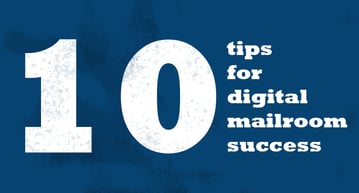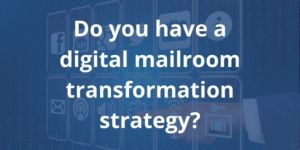
How to create a world-class Digital Mailroom

Tim's Top Ten rundown for a successful Digital Mailroom in 2021
- Be the customer - and have joined-up thinking
- Review the market - and see what your peers are doing
- Review the technologies - to see the art of the possible
- Review your back end – Seriously!
- Review your people – Happy staff, happy customers
- Set out a journey - with deliverable milestones
- Get to base camp - quickly
- Review the Stats - and the sentiment
- Reset your compass – Now what?
- Keep aiming for the stars - with plenty of rest stops.
1. Be the customer and have joined-up thinking
If you have read my series on Digital Mailrooms, then you will know, I have been making a big point about this, customers don’t care about your internal issues or historical technology or outsourcing choices. When they want (or need) to contact you, they will be making a decision about your service. Depending upon the time of day, their location, or circumstances, they might write to you, email you, visit your website or portal, interact with a chatbot, upload documents or just ring a number if one can be found on your website! (How many B2C providers hide any reference to a telephone number these days!). They might do this from a mobile, tablet, desktop, landline, or sheets of paper. This is your chance to shine. You have taken their money now you can serve and delight them and show in the amazing nature of this interaction that you are the right choice to continue to serve them and indeed expand what you do.
Or, it is the time they will have serious questions. “I mailed you an original Death Certificate two weeks ago how come you are saying you still haven’t got it!”, “I rang your number and waited on hold for over 20 minutes then got an outsourced call centre who knew nothing about what I needed to talk to you about!”, “I spent 20 minutes on your website and couldn’t find how I can send you this document and even when I did upload it, it didn’t say you had it or that it was the correct document?”. It's in these 20 minutes of frustration or delight that the decision as to whether you will retain them as a customer and have them singing your praises, or lose them forever.
A true digital mailroom will be just one application of an intelligent automation platform that allows you to create a strategy and journey towards delighting your customers, by becoming hyper-efficient, compliant, and in control of any channel of communication - paper, email, web, and mobile.
So, it is hard talk time! Ignore your history, knowledge of why things are as they are and look with fresh customer eyes at your processes and how they are designed to delight customers.
Customers don’t care if your customer service staff report to the COO and the web site or portal reports to your CMO and email and systems report to the CTO. In effect your COO, CMO and CTO all report to the customer! They expect a joined-up and world-class service. If you can’t give this to them, then there are plenty of others out there who will, which leads me on to the next tip.
2. Review the market - and see what your peers are doing
This is something that every customer knows but it seems many corporate executives have forgotten. How much time do you spend being your customer and exploring what other offers are out there tempting them away like siren calls to other providers?
I don’t know if any of you have watched a TV show called Kitchen Nightmares with Gordon Ramsey, but the one thing that seems universal on that show (apart from constant swearing) is that all the troubled restaurants think that they are great. Their food is wonderful, the price is right, and the service is excellent, they just don’t understand why they are empty and on the verge of bankruptcy. Gordon or his team will often walk around town and see what other restaurants are doing and most importantly they will ask the public what they think.
This is often the point at which the future of the business is made or lost as if there are others out there doing better and you can’t adapt and create a unique offer then you are doomed. Remember business 101, you compete on price or differentiation, period.
So how do your competitors deal with customers' documents and communication? Have they invested in the latest Artificial Intelligence and Machine Learning tools and digital assistants to augment, complement, and help their staff to create an awesome experience? The business oxymoron is that these tools will allow you to offer efficient service. Normally you are either efficient or provide great service.
The other thing with awesome technology, it that it is both seamless and seen less. Processes just work and your customer support teams can look like majestic swans whilst the digital assistants, AI, and machine learning all work “under the water” and out of sight. This is so different to most people’s experience when they are sending in information, the processes seem like they came out of the ark. So, if your competitors are using better technology to help the process than you, then it is time to look to see what is out there.
3. Review the technologies - to see the art of the possible
This is an obvious point but often companies will engage procurement and create a tender based on their current needs without spending the time to see what is truly possible. Imagine a caveman or cavewoman asking for a vehicle and they would probably be delighted with the Flintstones car. Now if they had test-driven a real car or helicopter, what would they ask for then? Also, most requirements are created by the teams that do the job now, and often they haven’t been given the time to review the market to see what their competitors do or what the latest technology can offer.
The other biggest problem is that they only solve the current biggest problem. What do I mean? Well, take the Covid Pandemic, this led to it being difficult, impossible, or risky to have staff coming in to process inbound post. So, the problem is paper handling, therefore the answer is to outsource to a bureau and make the problem go away. Actually, the “problem” is how do I delight customers at every interaction and have a safe low-cost, scalable, compliant, and awesome process!
Yes, you can outsource, like the cave person looking at a shiny Flintstone Car. But hey, what if a technology existed that could read documents (from any source, paper, email, web uploads) like a human and process them in a hyper-efficient, near real-time way only referring to your staff by exception and it learned from their interaction and became more efficient over time (Yes, this is Kofax and a very unsubtle sales pitch! But it is over now, so it is safe to read on).
Actually, when you are looking for a Digital Mailroom you should be looking for something that will;
- Increase customer satisfaction
- Increase Staff satisfaction.
- Increase operational efficiency
- Increase speed, accuracy and control
- Bring compliance and standard operating procedure with all interactions being automated and monitored throughout
- Scale quickly to demand
- Allow you to be Agile and flexible and read the results from paper, emails (with any attachment) , web traffic or portals and in this way you can cope with major changes like Covid or more positively mergers and acquisitions or fluctuations in business levels.
- Reduce Internal costs allowing you to compete and win more business at a higher margin
- Keep happy staff focused on value added knowledge work , whilst the automation and robotics eliminates manual tasks.
Seriously the sky is the limit. Be careful not to look at point, or siloed solutions that may fix the paper or email or website, look for ones that solve the whole thing. Go look for what is out there, and you might be surprised that actually, you can solve not jut the most urgent problems, but also the really important ones too.
4. Review your back-end - seriously!
There is no point looking at wonderful new technology to augment your systems if your current systems suck! Lipstick on a pig anyone? So many times, in projects over the years, we have been limited, hampered, or held back by poorly designed legacy systems. So, a harsh reality is that you may need a new ERP before dressing it with a world-class, AI-driven Digital Mailroom. Just like you might want to go to the gym and watch your diet before buying that brand new suit that looks awesome on the shop dummy. I believe it needs to be what’s on the inside as much as what’s on the outside. However, don’t underestimate the power of automation and robotics, this can make up for a lot of poor design
5. Review your staff - happy staff, happy customers
All too often your people are left out of the equation. We all know great companies where every person or system we interact with is just … well …great! I have written before that you can feel the passion and sense that this firm is on a mission to greatness. So, what do your team need from the systems and technology to put a smile on their face that they can then share with your customers?
Perhaps it is easier to find out what frustrates them. You might be opening Pandoras box, but isn’t it better to know what the roadblocks are to a happy team so that you can knock them down? How often is there a disconnect when the customer rings and chases information that they have sent and the person fielding the call bears the brunt? They can’t say “we outsourced our mailroom and the new provider is rubbish and takes longer, makes more mistakes and isn’t in the same time zone”, “No if you mailed it that goes to one team, if you emailed it, then that is another team and if you uploaded it to the website that is another team”. You get the point.
Again, another TV show to illustrate the point. Back to the Floor, where the CEO joins at the shop floor incognito and faces the same issues as his or her staff do. Every episode is a wake-up call to that CEO that the customer experience is often impacted most by the most junior employee and the obvious lists of things that would make life better are ignored by layers of management apathy or ignorance.
Just as your customers know what they want, so do your teams, ask them!
6. Set out a journey - with deliverable milestones
A Digital Mailroom isn’t a deliverable finite piece of technology. It is a strategy. The best strategy is to use an intelligent automation platform designed for the job and then plan for constant improvement over time. Crawl, Walk, then Run. The best intelligent automation platforms would reach far beyond the mailroom. So, set up a centre of excellence (COE) and get representatives from every department to join the COE and plan how automation can improve their department, customer and staff experience. From the CEO to todays new joiners, talk about your mission to improve things, and create a list of deliverable projects. Get every employee to think about themselves as a manager of a team of digital assistants and ask who they are hiring and how they are developing that team over time. Automation is exciting and empowering, but we need to be careful as you can quickly get requirement lists in the thousands.
7. Get to base camp - quickly
Too many projects are deemed a failure or not meeting the requirements as the expectations were set too high for the first phase, or even worse there was only one phase planned. With a digital mailroom you can segment your document types and sources and work in a logical way. You can also set process phases as well. A good one to look at is Capture to Case then Extract. By this, we can set up the Digital Mailroom to review all scanned paper, emails, and web / portal uploads and classify the documents, and put them into the right place. So we first understand what the document is, it is a claim, application, invoice, order, complaint, etc and then we file it to the right place to be worked. In the next phase, we can take all the data out of the document to feed the back end system. Or we could do end-to-end automation for one process e.g. AP.
For example if you haven’t seen it, an invoice sent in by paper, email, or posted to a supplier portal, can be automatically retrieved and classified (it is a PO invoice (not an overhead invoice or credit note, etc)) then we can find the supplier, PO, open line items, receipting information and extract all the data from the invoice automatically and compare that to the business rules of the organisation to check for duplicates, invalid data and make sure only data in good order finds its way into the business. Information Not in good order can be automatically returned to the sender in near real-time to help them out. E.g I am asked to upload a document to a company’s website, so at midnight because I am a customer ! I browse to the document on my laptop and hit submit, and in this same session within a second or two the document is read and checked, and I get instant feedback, “We have noticed that you haven’t signed this, could you sign it and upload it again” or “this document is out of date we need one issued in the last six months please” etc.
The point is, we need to get this phase in quickly. If it is more than 8 weeks, you need to question the scope.
If you have chosen the right platform, then you can be looking at phased delivery in hours or minutes. I sat in one meeting where the Head of IT gave a lecture on the huge project lengths associated with Robotic Process Automation. He warned that this kind of technology needed developers, project managers, and months of phased delivery from a large team. I smiled when the Head of AP interrupted him and she said “actually I built a robot this morning and it took me 10 minutes and is already saving me time”.
8. Review the stats - and the sentiment
Once you have your base solution in, then you can review the inbuilt process analytics to show you where the next piece of work needs to focus. The right platform will monitor the whole process, from cradle to grave and track how many steps were automated and when and if a human was involved and how long they took and record every keystroke they made. Using this deep understanding we immediately see where the new problems are, what is working well and what needs to be fixed now! So make sure you spend as much time looking at the process analytics that comes with a digital mailroom as the core technology as this will be your guide to future success.
Also, as a by-product of a Digital Mailroom, as every customer communication passes through a natural language processing engine, we can score the happiness of every interaction on the route. So, you can tell how happy your customers are with your processes and service. Again you can highlight any urgent needs and focus the next phase of improvements on these.
9. Reset your compass - now what?
Once you have delivered the perfect Digital Mailroom, what next? Well according to tip 8, this will be a self-answering question as the analytics discussed above will identify the next step to improve the system. But, this is only the tip of the iceberg. A Digital Mailroom built using an intelligent automation platform is now a resource for the whole business to drive compliance, efficiency, service, and satisfaction. Customers that embrace intelligent automation platforms have them at the heart of their business and continually look to improve and serve better.
Unhappy staff often become unhappy through frustration. If you know a bad part of your job, a boring, repetitive, and frankly drone-like task will always be there forever, it will gnaw at your soul. If, however, you are empowered to remove these chores and continually allowed to improve what you do the difference is staggering. Survey after survey shows that before automation staff are worried, yet afterwards they are much happier and free to be a human and embrace the technology and want to drive it to achieve more and more.
10. Keep aiming for the stars - with plenty of rest stops
This isn’t just for Digital Mailrooms but for many IT projects, especially intelligent automation platforms. It is important to keep aiming for the stars. Loop through this list on a regular basis and set your course to the moon then mars. It is important in long deliveries to celebrate success regularly and ensure, like sleep, we get a chance to rest, reflect, and take on tomorrows’ challenges on the back of yesterdays successes.
So that wraps up my top ten tips for delivering digital mailrooms. Did I miss any? What have your experiences been? Do you agree with me? What questions has this series brought up for you? Let me know and I will be happy to answer.
Want to know more?
Twofold Ltd assists businesses to overcome these challenges with our range of mailroom and data solutions. From mailroom equipment, scanning and capture, to document management and full digital transformation, contact us via the form here, or give the team a call on 0118 951 9800.
Tim Miller
Digital mailroom Specialist

.png?width=828&height=208&name=Twofold-Logos-no%20drop%20(1).png)



